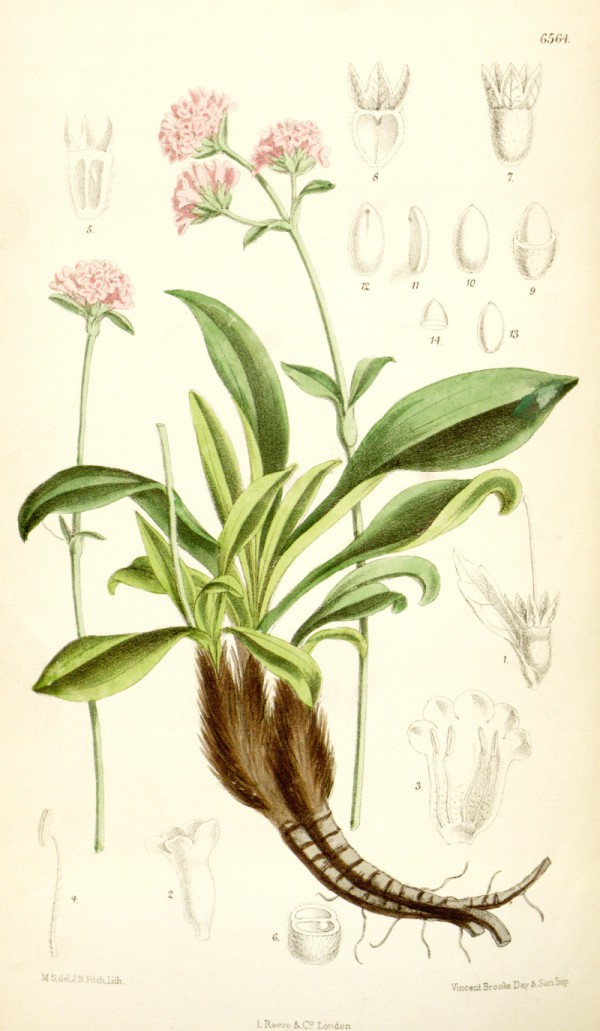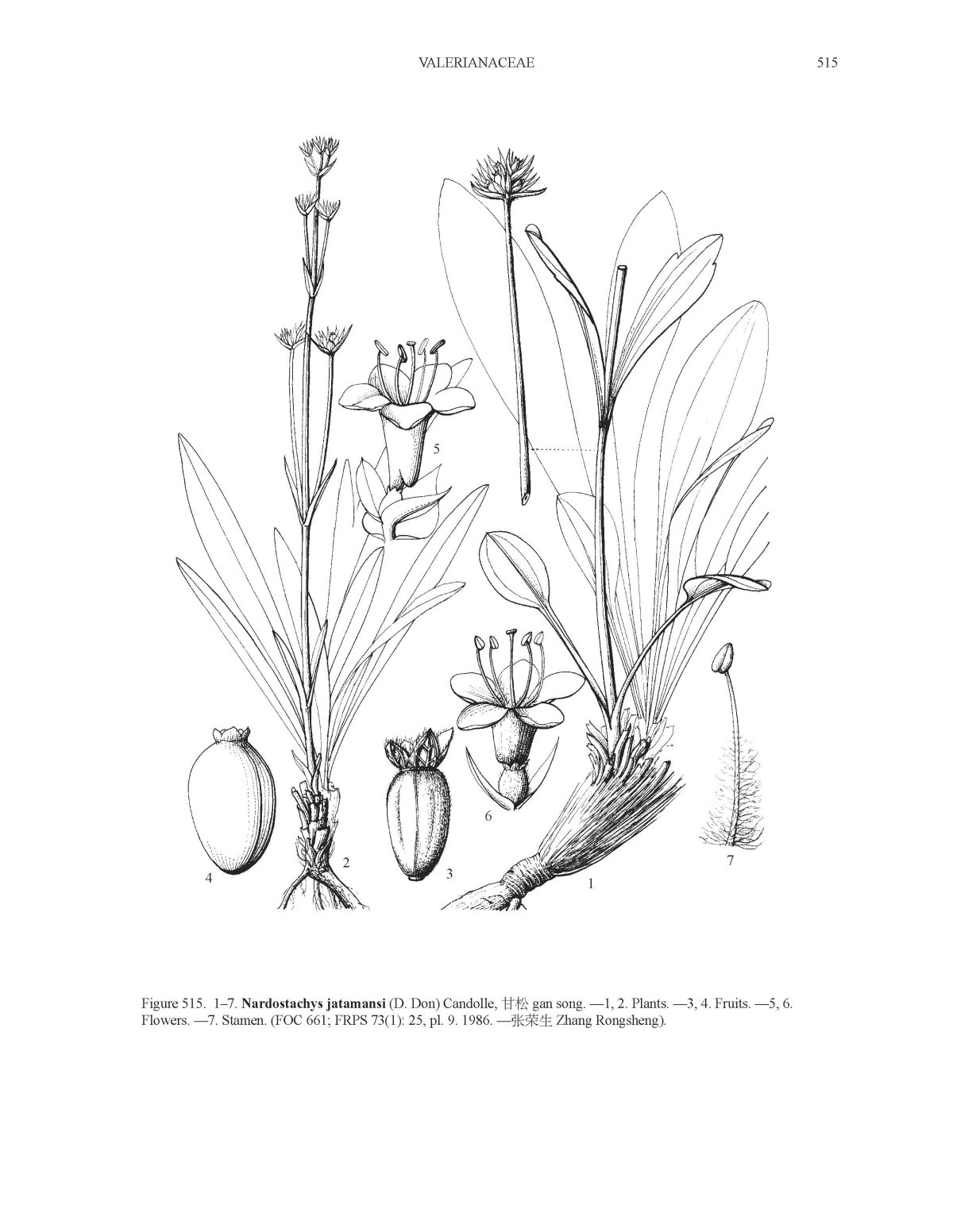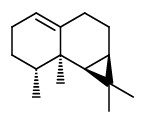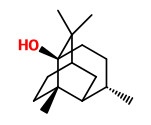Nardostachys jatamansi (D.Don) DC. - syn. Nardostachys chinensis Batalin; Nardostachys grandiflora DC. - Valerianaceae
甘松 gan song (chin.), nard, spikenard, muskroot, Indische Narde, Nardenähre, Speichenähre
Perennial herb, 5-50cm tall, native to Bhutan, India, Nepal, China; rhizomes stout, short, branching; rosulate leaves narrowly spatulate or linear-oblanceolate, 3-25cm long, glabrous or sparsely puberulent, veins 3, base attenuate, margin entire, apex obtuse; cauline leaves mostly 2- or 3-paired, lowermost elliptic to obovate, base attenuate into petiole; uppermost sessile, oblanceolate to lanceolate, sometimes sparsely serrate; corolla purple-red, pink, or magenta, campanulate, 4.5-9 mm, 5-lobed; achenes obovoid, 3-4mm, partially or uniformly white hispid or glabrate.
http://www.efloras.org/florataxon.aspx?flora_id=2&taxon_id=200022534
Probably the plant of the „nard oil“ of the bible. http://en.wikipedia.org/wiki/Nardostachys_jatamansi
From greek „nárdos“ = fragrant. http://de.wikipedia.org/wiki/Indische_Narde
„Nardostachys jatamansi (D. Don) D.C. of the family Valerianaceae is a small herbaceous Himalayan species found between 3000 and 5000 m asl. Nayar and Shastry (1988), the CAMP report (1997) and Airi et al. (2000) identify N. jatamansi as a critically endangered species of Northwest Himalaya. It is a perennial, dwarf, hairy, rhizomatous herb forming a group or cluster of several individuals with thick rootstock covered with fibres. It has a long juvenile phase (vegetative growth phase) of 3-4 years followed by a short reproductive phase. Propagation is clonal during the vegetative growth phase and seed germination is very low (10-20%) in nature.“
[Nautiyal, B. P., et al. „Population studies for the evaluation of germplasm and threat status of the alpine medicinal herb, Nardostachys jatamansi.“ Plant Genetic Resources Newsletter (2003): 34-39]
„β-Maaliene, 9-aristolene, calarene and patchouli alcohol were identified as the major volatile constituents of N. chinensis, whereas aromadendrene, cube-11-ene, epi-α-selinene, spirojatamol and valeranone were identified as those of N. grandiflora. Using the peaks of β-maaliene and 9-aristolene in GC profiles as the marker, two Nardostachys species were clearly distinguished among the samples examined.“
[Tanaka, Ken, and Katsuko Komatsu. „Comparative study on volatile components of Nardostachys rhizome.“ Journal of natural medicines 62.1 (2008): 112-116]
SPME-GC-MS analyses of an hexane extract of spikenard showed the main components calarene (82.3%), aristolene (8.3%), and valerena-4,7(11)-diene (3.9%).
[Takemoto, Hiroaki, et al. „Sedative effects of vapor inhalation of agarwood oil and spikenard extract and identification of their active components.“ Journal of natural medicines 62.1 (2008): 41-46] http://borraikrisana.com/fulltext.pdf
Sleep time of pentobarbital-treated mice was prolonged by about 2.7 times with valerena-4,7(11)-diene isolated from spikenard, an effect similar to that of chlorpromazine administered orally.
[Takemoto, Hiroaki, Toru Yagura, and Michiho Ito. „Evaluation of volatile components from spikenard: valerena-4,7(11)-diene is a highly active sedative compound.“ Journal of natural medicines 63.4 (2009): 380-385]
„The essential oil was extracted by hydrodistillation from the N. jatamansi roots, collected from local market. The yield of oil was 0.245%. The gas chromatography coupled with mass spectrometric analysis revealed the presence of 26 compounds, out of which 10 principal components were, identified. It was recorded that ledene oxide[II] (13.021%), and sesquiterpine alcohol patchouli alcohol (9.582%) were major component of the oil. [-]-spathulenol (2.672%), globulol (1.876%), 4-[3,3-dimethyl-but-1-ynyl]-4-hydroxy-2,6,6-trimethylcyclohex-2-enone (1.849%), megastigma-4,6[E],8[Z]-triene (1.015%), aristolene(0.997%), β-vatirenene (0.932%), were present in considerable quantity.“
[Essays, UK. (November 2013). Volatile Constituents Antibacterial And Antioxidant Activities Biology Essay.] Retrieved from http://www.ukessays.com/essays/biology/volatile-constituents-antibacterial-and-antioxidant-activities-biology-essay.php?cref=1
The main components of the hydrodistilled essential oil from Nardostachys jatamansi roots (yield of 1.07% v/w, based on dry weight) were calarene (25.9%), patchoulol (10.6%), α-gurjunene (7.5%), aristolone (7.1%), β-maaliene (6.5%), and spathulenol (4.3%). Minor components included the typical valerian odour-determining isovaleric acid (1.5%), 3-methylvaleric acid (2.3%), and valeric acid (0.4%) together with e.g. 1.8-cineole (3.6%), β-ionone (1.0%), and α-bulnesene (1.4%).
[Liu, Xin Chao, and Zhi Long Liu. „Evaluation of insecticidal activity of Nardostachys jatamansi essential oil against some grain storage insects.“ Journal of Entomology and Zoology Studies 2.4 (2014): 335-340] http://www.entomoljournal.com/vol2Issue4/pdf/78.1.pdf

Nardostachys jatamansi, Curtis’s Botanical Magazine, vol. 107 [ser.,3 nr.37], t.6564 (1881) [W.H.Fitch]
http://www.plantillustrations.org/species.php?id_species=691793

Nardostachys jatamansi, Flora of China



